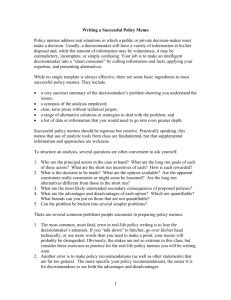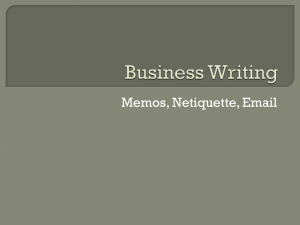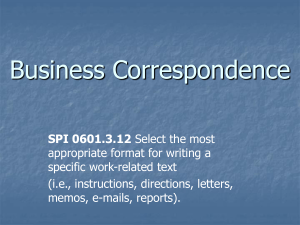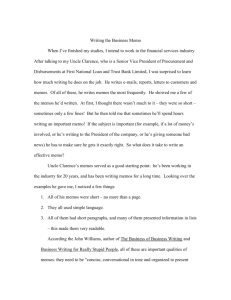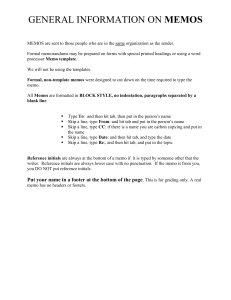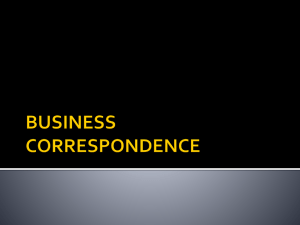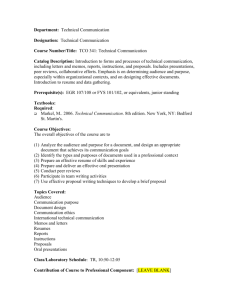Memos
advertisement
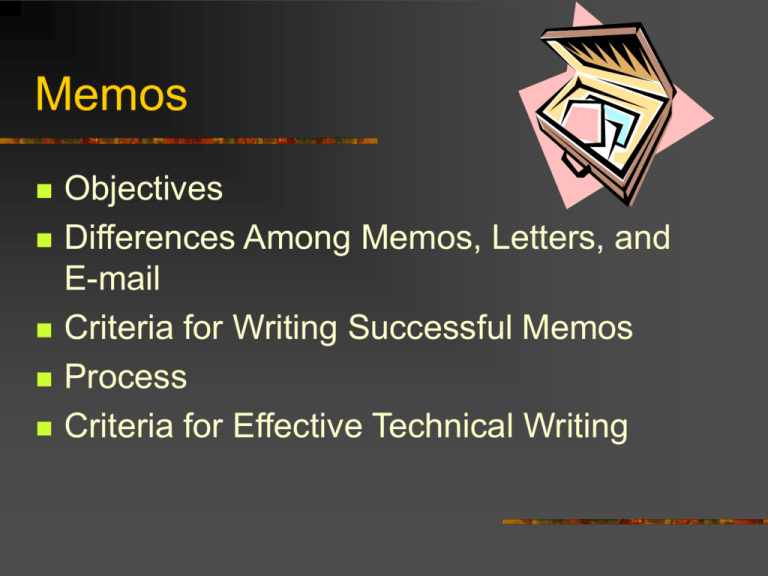
Memos Objectives Differences Among Memos, Letters, and E-mail Criteria for Writing Successful Memos Process Criteria for Effective Technical Writing Objectives of Memos Written and read only within a company Represent a component of your interpersonal communication skills within your work environment Memos vs. Letters and E-mail Characteristic Memos Letters E-mail Destination Internal External Both Format Date, To, From, Subject Letterhead address, date, reader’s address, salutation, etc. Subject, From, Sent, To Audience Business colleagues High-tech to low-tech Informal Vendors and clients Low-tech to lay Multiple readers More formal Usually informal Hard copy attachments 8.5” x 11” 55 lines page Within 3 days Additional information 8.5” x 11” 55 lines page 3 days or more Computer files, Web links One screen 12-14 lines Within minutes Company – work ethics US Postal -reliable May be tampered with Topic Tone Enclosures Structure Delivery Time Security Diverse topics Criteria for Successful Memos Subject Line The beginning of the memo Typed in all CAPS Gives the topic (the what) plus a focus (the what about the what) More than one word Criteria for Successful Memos Subject: FOCUS plus TOPIC Termination of Comptrollers Hiring Procedures for Comptrollers Vacation Schedules for Comptrollers Training Seminars for Comptrollers Although the topic stays the same, the focus changes and clarifies the actual subject matter of the memo. Criteria for Successful Memos Introduction One or two clear introductory sentences which tell your readers what you want and why you’re writing In the third of our series of quality control meetings this quarter, I’d like to get together again to determine if improvements have been made. Criteria for Successful Memos Discussion Respond to the reporter’s questions (who, what, when , why, where, how) Apply highlighting techniques Itemization White space Boldface type Headings Columns Graphics Criteria for Successful Memos Conclusion Complimentary close Motivates readers and leaves them happy If our quarterly sales continue to improve at this rate, we will double our sales expectations by 2000. Congratulations! Directive close Tells your readers exactly what you want them to do next or what your plans are (dated action) Next Wednesday (12/22/00), Mr. Jones will provide each of you a timetable of events and a summary of accomplishments. Criteria for Successful Memos Audience Memos average six readers. May use more acronyms and internal abbreviations. Provide parenthetical definitions if your usage differs from what most people will assume. Criteria for Successful Memos Style Use simple words, readable sentences, specific detail, and highlighting techniques. Strive for an informal, friendly tone. Reflects your interpersonal communication skills. Tone is achieved through audience involvement (you usage), contractions, and positive words. Writing the Memo Prewrite and review your prewriting. Determine your focus. Clarify your audience. Review memo criteria. Organize your ideas. Write the draft. Writing the Memo Rewriting Add new detail for clarity Delete dead words and phrases for conciseness Simplify words and phrases Move information from top to bottom or bottom to top for emphasis Reformat using highlighting techniques Enhance the tone and style of the memo Correct for accuracy Avoid sexist language Effective Memo Checklist Have you used the correct memo format? Is your subject line correct? Does your introduction tell why you are writing and what you are writing about? Does the body explain exactly what you want to say? Does the conclusion tell what’s next and provide a close? Effective Memo Checklist Is your page layout reader friendly? Is your writing style concise? Is your writing clear? Do you answer reporter’s questions? Do you avoid vague words such as some, several, many, few? Have you written appropriately to your audience? Are errors eliminated? Criteria for Effective Technical Writing Clarity Conciseness Accessibility Audience Recognition Audience Involvement Accuracy

